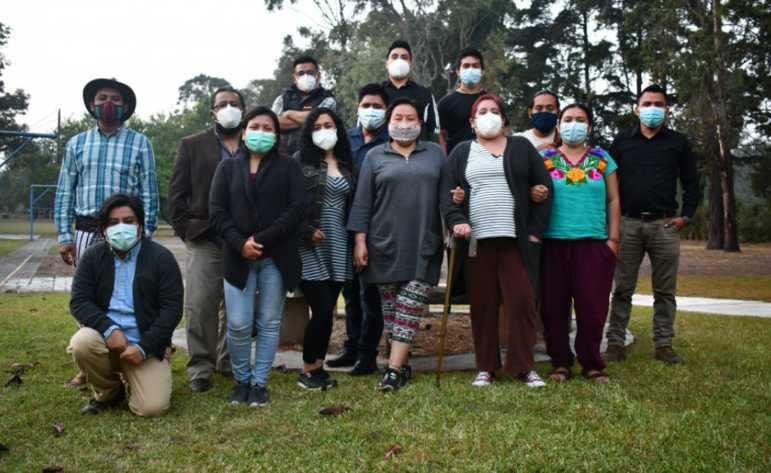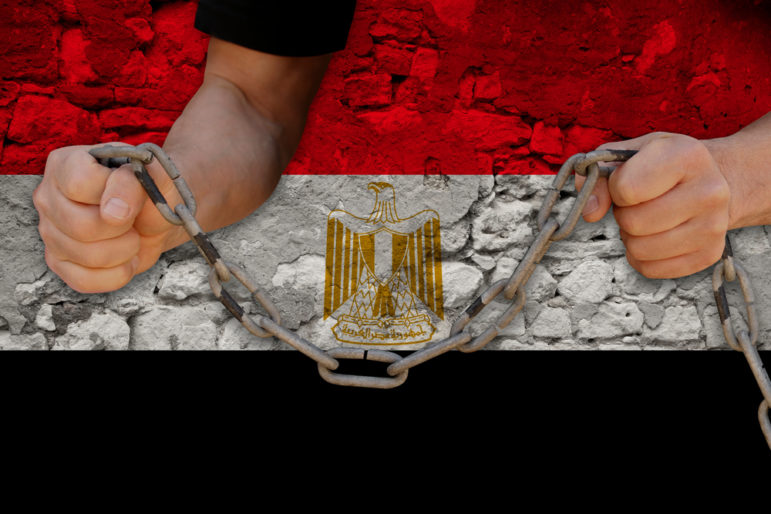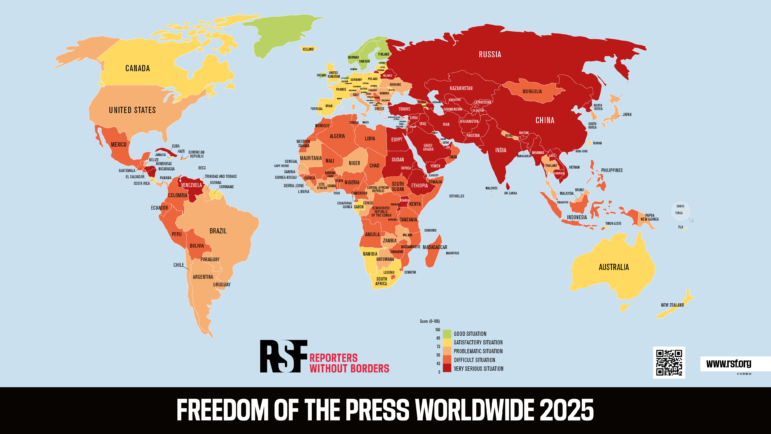

In a Hostile Climate, Reporters in Guatemala Fight for Investigative and Community Journalism
Read this article in

The team at Prensa Comunitaria Kilómetro 169 — a newsroom named in honor of the victims of a massacre of Indigenous people in Guatemala. Image: Screenshot
In an environment of increasing restrictions on access to public information, constant attacks by the president against journalists, and a high level of impunity for crimes against press professionals, digital media outlets in Guatemala strive to make and support investigative and in-depth journalism. For this, they use different tools and working methods: long narratives, data, community journalism, and even collaborations with artists.
According to Reporters Without Borders, Guatemala ranks 116th in the 2021 World Press Freedom Index. The NGO says endemic violence, organized crime, corruption, and impunity make reporting in the country “extremely difficult” and points out that murders of journalists are “very frequent.”
Organizations such as Human Rights Watch and the Committee to Protect Journalists (CPJ) warned in a statement earlier this year that President Alejandro Giammattei has attacked the press with “bellicose rhetoric and false accusations” since the beginning of his term in January 2020. The organizations have also highlighted how the government has restricted access to public information, which has worsened in the context of the pandemic.
More recently, in May, the implementation of the so-called “NGO Law” in Guatemala was condemned by several international bodies, including the Inter-American Commission on Human Rights. The set of measures gives the government extensive control of these organizations, including press freedom groups and nonprofit news outlets, CPJ said. In addition, the law makes it possible for the state, through a unilateral decision, to close an NGO when it considers that the organization “violated public order.”
In this context, LatAm Journalism Review (LJR) spoke with representatives of three digital media outlets in Guatemala, who spoke about the main challenges for doing investigative journalism in the country, and how they are innovating and investing in new narrative and business strategies.
Agencia Ocote

Julio Serrano, Alejandra Gutiérrez Valdizán (middle) and Lucía Reinoso, of Agencia Ocote. Image: Screenshot
Agencia Ocote’s founding partners spent two years planning the new digital media outlet, including drafting a strategic and sustainability plan, before its launch in 2019.
According to Alejandra Gutiérrez Valdizán — co-founder, general coordinator, and editorial director of Ocote — the motivation for creating the agency came from identifying specific public needs, and having a space to explore transmedia narratives.
“A theme that stuck with us at all times was the need for women to start media outlets and lead them… because we believe that it is not just a matter of focusing on gender and issues focused on women, but also of changing some dynamics of media newsrooms,” Gutiérrez told LJR.
Of the founders, three remain at Ocote: Julio Serrano Echeverría, a male audiovisual artist and poet, and two women: Lucía Reinoso Flores, who specializes in audiovisual production and digital communication, and Gutiérrez, who is a journalist.
The outlet, which focuses on in-depth journalism, has some priority themes for coverage, which they call “programmatic lines.” One is women and diversity, and the other deals with the media, which includes monitoring and profiling threatened journalists in the country. This programmatic line also encompasses Ocote’s fact-checking project, called Fáctica, which participates in fact-checking networks such as Latam Chequea.
Another important theme is culture, which the agency understands not only as entertainment but as “a social explanation and political act.” Finally, there is a programmatic line on the environment and another on historical memory and justice, because, according to Gutiérrez, the country is a “post-war society.”
“Bear in mind that in Guatemala there was a 36-year war in which there are still transitional trials, for example, and we believe that this coverage is still important, because it seems that the issue has already passed — and it hasn’t,” she says.
In addition, Gutiérrez highlights Ocote’s participation in the Guatemala Leaks project, a media network that produces “more classic investigative journalism on corruption and impunity,” as well as COVID-19 coverage projects, such as those with health and science media outlet Salud con Lupa.
Ocote’s plan is to gradually expand its programmatic lines. These themes were chosen, Gutiérrez says, not only because they are important and interesting to the team, but also because they believe they are areas “which the traditional press or other media are not covering with the depth or frequency that is required.”
One of Ocote’s differentials, Gutiérrez says, is a multidisciplinary approach, in which they experiment with collaboration between journalism, social sciences, and the arts. According to her, the classic methods of investigative and in-depth journalism have a greater weight in their work, but the agency always seeks to present the content in a different way.
“We launched a regional special last year that Ocote coordinated, which we did with [El Salvador’s] El Faro and [Honduras’s] ContraCorriente, and the bulk of it was data journalism and hard reports about violence against women,” she says. “But then there was another part in which artists did a kind of reinterpretation of the journalistic work, a visual project was done on that.”
For Gutiérrez, the worst attacks against the newsroom have come in retaliation for investigations into issues related to women and harassment. There have been threats, intimidation, and attempts to discredit journalists and the media, often coming from anonymous accounts. “There are disinformation groups, very conservative groups in Guatemala … which, well, are also keeping an eye on us,” she says.
At the same time, she points out that it is community journalists working outside the capital who are at greatest risk in the country. “I wouldn’t dare compare us,” she noted.
After two years of operations, Ocote currently has a newsroom of 12 people. The agency is financed mainly with funds donated by national and international organizations and foundations. In addition, they are investing in editorial projects and in making financial contributions from readers possible. Since 2018, they have also run an agency that sells communication and production services.
Agencia Prensa Comunitaria Kilómetro 169
The agency Prensa Comunitaria Kilómetro 169 was created in 2012, and was named after a massacre of Indigenous people by security forces that took place in the same year in the jurisdiction of Totonicapán, says sociologist Francisco Simón Francisco, who is also an investigative journalist at the outlet. “Prensa Comunitaria takes on that other name, KM 169, in honor of the massacre that occurred at kilometer 169” of the Pan-American Highway, he explained in an interview with LJR.
The outlet, with a community and multidisciplinary focus, is composed of a team of Indigenous and Mestizo staff, who have mixed ethnic heritage. Fifteen people make up the core team, but there are a total of 45 departmental correspondents, including journalists, academics, and social scientists. To finance the project, they carry out consultancy services, sell communication services, and receive money from philanthropic funds and grants.
Its headquarters are in the capital, and correspondents are spread across several departments or regions of the country, mainly in rural areas and Indigenous territories.
“We live in the communities, we are part of the events, we are the subjects of the events,” he says.
According to Simón, the outlet decided to cover the humanitarian crisis resulting from the “imposition of the extractive model” in the country and, along with that, themes related to feminism, Indigenous peoples, and migration.
“Our interest is to show the efforts they make and the threatening situations that these peoples go through in their territories, such as the dynamics of dispossession by hydroelectric dams, mining, and monoculture,” says Simón, who started working at Prensa Comunitaria in 2014.
In addition, they report on the humanitarian crisis caused by hurricanes Eta and Lota, which hit the country last year, and issues related to freedom of the press and expression. Responsible for the Prensa Comunitaria Self-Care and Protection Program for Community Journalists, Simón says that his goal is “to dignify this community work, with social and legal recognition.” This is because, he says, there is no legal framework that regulates the profession of community journalists, who suffer from racism and discrimination, including judicial persecution and criminalization.
“In Guatemala, although it is true that there are laws that guarantee and advocate freedom of the press and expression, there is no law that recognizes the work carried out by journalists or communicators from the provinces,” he says. “Many times, the same society does not recognize them.”
He also believes that community journalists are more exposed to risk, and says reporters at Prensa Comunitaria have already been victims of physical aggression, censorship, and threats.
“The risk, at least for those of us who practice journalism with social science methods, is high, because our investigations are long-term and involve fieldwork,” he says. “We visit [the communities] and we come across organized crime, drug trafficking, and the smuggling of people.”
Simón says attacks on journalists are often carried out by the authorities and public officials.
“A prosecutor from the public prosecutor’s office forced [a journalist] to delete some photos that she took of a murder in the community,” he says. “In other words, the restriction to the exercise of journalism is not only carried out by local authorities, by the government, but also by the same judge, by the same prosecutor.”
No-Ficción
Planning for digital media outlet No-Ficción began in 2017 and the site was launched the following year by five journalists who had worked at media outlet Plaza Pública and were then freelancing. The idea, according to Oswaldo J. Hernández — a journalist and co-founder of No-Ficción — was to have a collective approach that would avoid the pitfalls of the journalistic ego.
“Many media outlets are unipersonal — that is, it is only the director who stands out, his name is what appears, and when something happens to the director, the whole project falls apart,” Hernández told LJR.
The collective’s proposal was to fill an information void. Hernández says, in Guatemala, traditional media cover the daily agenda, and alternative digital media outlets struggle to do that same coverage — and with a smaller staff. He says the collective believed there was a lack of structural analysis, and, therefore, it was necessary to “tell the story of the country well.”
“What we proposed was to start from the idea: ‘We are not going to tell you what is happening, but why it is happening, because we reached this critical crisis.'” he says. “We saw that Guatemala goes from crisis to crisis, from scandal to scandal, but no one could give it a form, because when you face that, you have scattered information in traditional media and you don’t give it a logical sense.”
And, to tell the story of the country well, No-Ficción bets on three aspects: narrative, investigation, and data, which is the collective’s slogan. Today, the outlet has ten professionals on board and is maintained through national and international funds.
No-Ficción focuses its coverage on topics such as transparency and corruption, organized crime and justice, the environment, interculturality, or the diversity of cultures in Central America, and public services — which include human rights, health, and education, among others.
According to Hernández, one of the most tense moments, in terms of attacks, was when the team was intimidated by sports officials while they were investigating corruption in the sector. He warns that journalists should not “victimize themselves,” and says that, in his newsroom, they take precautions, such as improving digital security and investing in partnerships with organizations that support human rights defenders.
He says these alliances serve to increase each outlet’s influence and impact in other countries in the region, because, as they become better known, they feel more protected. At the same time, the regional media network can help to find shelter in another country should a journalist need to leave Guatemala in an emergency.
Hernández says he is concerned about groups referred to by the United Nations International Commission against Impunity in Guatemala (CICIG) as “illicit political-economic networks.”
“A phenomenon in Guatemala is that the illegal bodies and clandestine security apparatuses that worked from state intelligence in the 1980s still persist today,” he says. “We have had intimidation from these groups. They are a clandestine parallel body; they are state officials, but at the same time they have their fraternities outside the state with lawyers, businessmen, and with all the structure, including drug trafficking.”
Hernández claims that these groups are in the habit of making files on journalists, and that the names of No-Ficción professionals usually appear on those lists.
In addition to security, Hernández cites a lack of transparency among authorities and public officials as one of the difficulties in carrying out investigative journalism in Guatemala. He says that, recently, requests for information made an access to information law are no longer being fulfilled. The data may sometimes be sent, but it takes time to arrive.
“Yes, they deliver it, but they tire you, they exhaust you — you even have to file legal recourse to see if they deliver,” he says.
For him, there has been a deterioration in transparency with the arrival of Giammattei as president. “There is greater reticence among employees to deliver information,” he notes.
Hernández also describes the NGO law as a threat, and says the country is experiencing a setback after years of progress with CICIG. He says this period of fighting corruption was “a springtime” in which “even the president had to resign” and “it was possible to strike traditional power.”
However, he says these sectors have coordinated a counterattack.
“They have co-opted the Constitutional Court, the Supreme Court of Justice, and the chambers of appeal, the Congress of the Republic, and the executive power — the presidency,” he says. “The difficulty we have as journalists is to confront the monster that is being created that is fighting for impunity, and for the decline of all democratic credibility, and they deny us documents and deny us sources.”
Hernández says that “when a state becomes authoritarian,” there is “fertile terrain for investigation,” but that there are also concerns for the safety of journalists.
“We are seeing an authoritarian system that is being developed gradually — not like in El Salvador, which is already evident all at once,” he says. “In Guatemala it is happening gradually — we see that the state is coordinating in a worrisome way.”
Additional Resources
Under Attack: El Faro’s Gutsy Reporting in Latin America
How Latin American Media Outlets are Collaborating on COVID-19 Investigations
Investigating Femicide: A GIJN Guide
This piece first appeared on LatAm Journalism Review on June 16, 2021, and is republished here with permission. It has been edited for style.
 Marina Estarque is a Brazilian journalist based in São Paulo. She has worked for Brazilian news organizations such as Folha de S.Paulo, O Estado de S. Paulo, and O Dia. She was a correspondent for the German international broadcaster Deutsche Welle and a radio reporter for DW Africa in Germany.
Marina Estarque is a Brazilian journalist based in São Paulo. She has worked for Brazilian news organizations such as Folha de S.Paulo, O Estado de S. Paulo, and O Dia. She was a correspondent for the German international broadcaster Deutsche Welle and a radio reporter for DW Africa in Germany.











